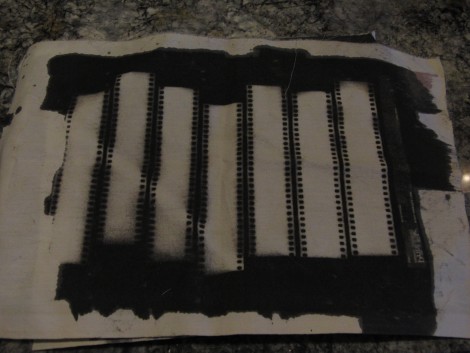
If you’re into developing your own photographs you might try mixing your own emulsion. [Jimmy Hartnett] worked out the chemical reaction necessary to make a photosensitive medium using Silver Chloride. His process lets him manufacture canvas that can be use like photo paper. The gist of it involves coating the back of a canvas with Gesso to prevent the emulsion from passing all the way through. He then floats the canvas face-down to apply the emulsion and skims it with a straight edge before it has time to set. You can see the results of some contact print testing in the image above. If anything, this makes a great piece of art to hang on the wall as it’s visually interesting and [Jimmy] has a personal connection because he not only made it himself, but came up with the process.















The title is incorrect, it’s photo emulsion. Emulsion is what receives light and changes its properties accordingly. Photo development, done in photo developer (development solution) and fixer, is what you do to make the pictures visible.
Oh yes, and a super cool photo hack!
Too bad it’s not useful for PCB etching (he says the wet solution reacts with “metal”, which I assume includes Cu).
It’s still a pretty cool chemistry project, though.
Nice, I have been hunting around some photography sites for this exact thing. We will see if its useful for what I need, good post.
Check out this link…
http://www.cameratruck.es/?page=project
a marriage made in heaven.
@Hirudinea
That’s one impressive camera. Thanks for sharing.
I appreciate the spirit of the project but there are already so many formulas that work. Even non sliver based emulsions.
Here’s a place where photo nerds go for emulsions
http://www.alternativephotography.com/wp/
I have books on processes like this. It’s fun stuff.
Some of us old timers were doing this back in the early ’80’s.
If you want to see something really interesting, look up “Sabattier Effect” or “pseudo-solarization”.
@The Steven
I’ve used that effect quite a lot in the Darkroom, always been a personal favorite – I still need to scan the prints I made with it. (There is a whole storage area at my house for photo stuff I haven’t scanned in yet).
@ Tyler
I’ll be sure to check out some of the other processes!
-Jimmy
When I was a kid I tried to make a photographic emulsion from a recipe in an old science book. The local drugstore pharmacist refused to sell me the required chemicals, insisting I was going to make explosive silver fulminate instead, and he proceded to show me his hand which was missing a few fingers…
Anyway, his refusal diverted me from a photography hobby and started me on a fascinating new educational persuit, which culminated in serious bodily harm of my own in my senior year of high school.
The moral of the story? Be careful HOW you deny something (you may cause what you are trying to prevent)…
Perhaps obtaining silver chloride as used here is less of a problem than using the silver nitrate that was require in the photo emulsion recipe I was planning to use.
@tyler Altphoto is allright, but http://thelightfarm.com is a superior recourse for diy emulsions.